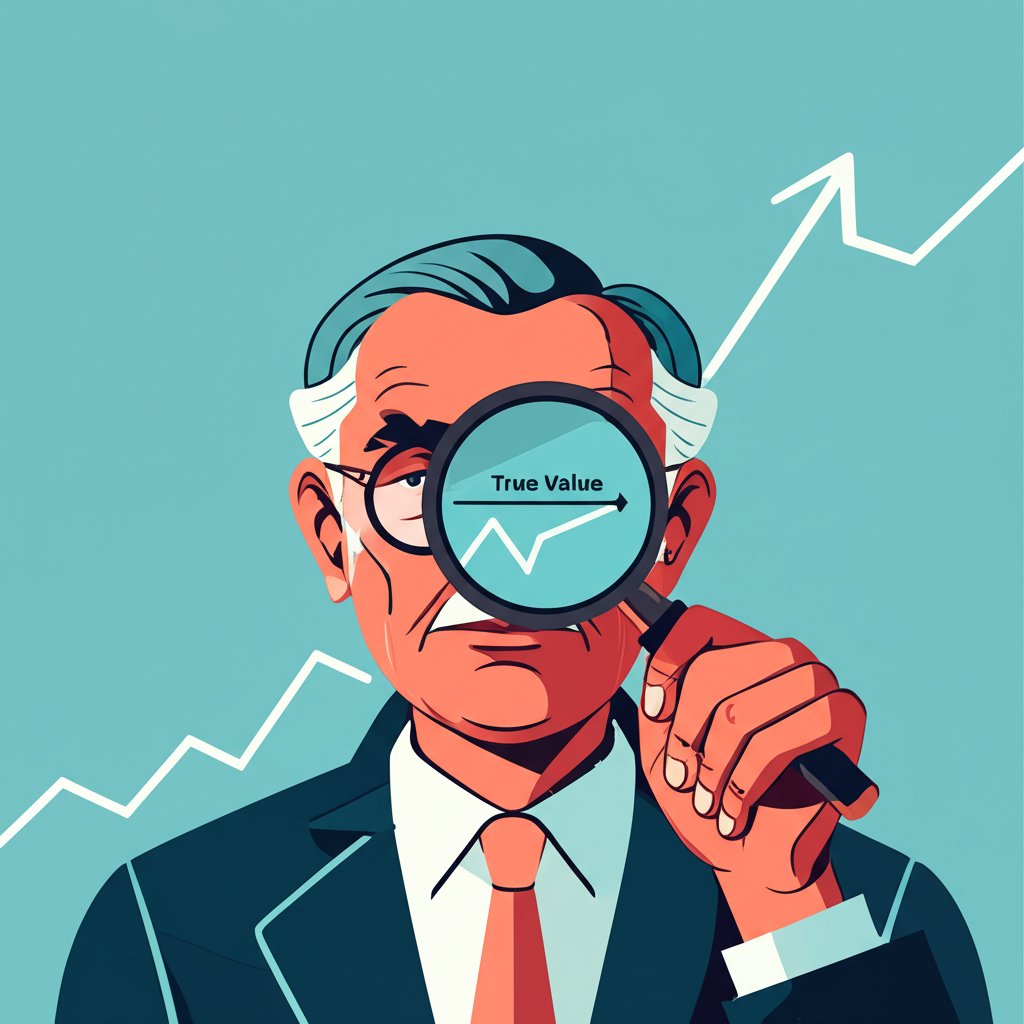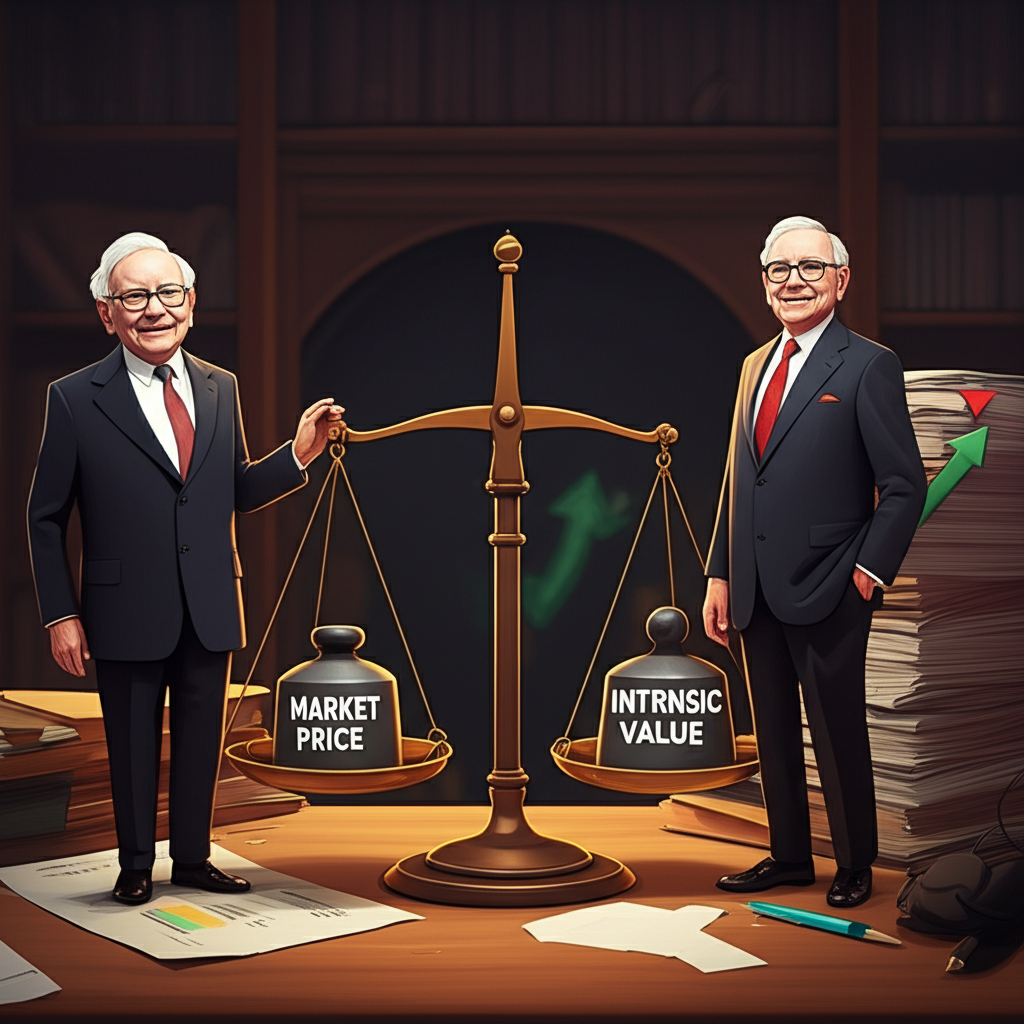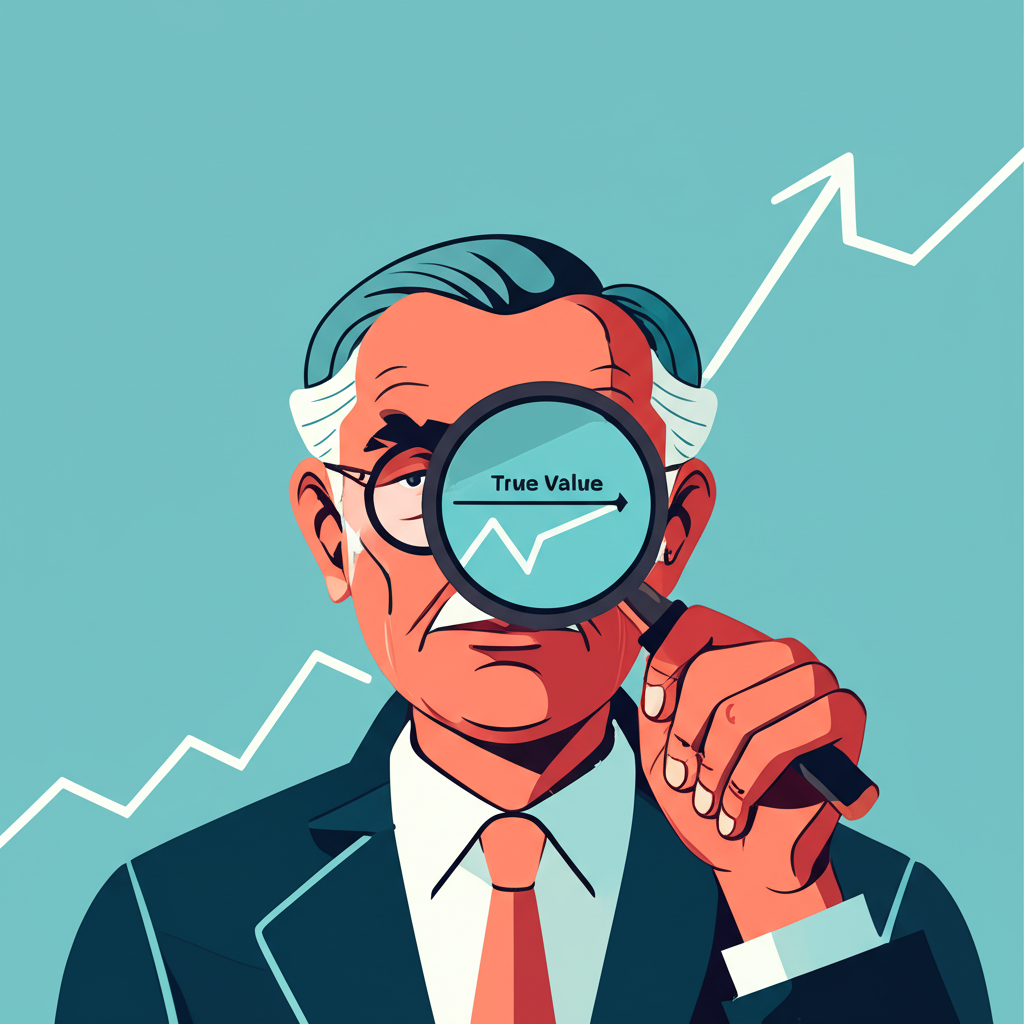Introduction: What is Intrinsic Value?

At its core, intrinsic value reflects the genuine, underlying worth of an asset—be it a company, stock, real estate, or even a philosophical idea—based on its inherent characteristics rather than its current market price. Unlike the often volatile and sentiment-driven market price, intrinsic value looks inward, focusing on fundamentals such as future cash flows, earnings potential, and qualitative strengths. This concept allows investors and analysts to cut through market noise and assess what an asset is truly worth over the long term. In finance, this principle forms the backbone of value investing, enabling decision-making rooted in substance rather than speculation.
The Financial Core: Intrinsic Value in Investment and Economics

Within financial theory and economic analysis, intrinsic value is more than a metric—it’s a mindset. It underpins fundamental analysis, where investors evaluate a company’s financial health, competitive advantages, and growth trajectory to estimate its true economic worth. Pioneered by Benjamin Graham and embraced by Warren Buffett, this approach treats stocks not as ticker symbols but as ownership stakes in real businesses with measurable value. When market prices fall below this calculated intrinsic value, opportunities arise. The divergence between perception and reality fuels value investing, where patience and analysis outweigh emotion and momentum. Economically, intrinsic value supports the idea that markets, while efficient over time, can experience temporary mispricings due to behavioral biases or external shocks.
Why Intrinsic Value Matters to Investors
For those building wealth over decades rather than days, intrinsic value isn’t just useful—it’s essential. It transforms investing from gambling into a disciplined practice grounded in logic and foresight. By estimating what an asset is truly worth, investors gain a strategic edge:
- Spotting Mispricings: A stock trading below its intrinsic value may represent a buying opportunity, while one above could signal overvaluation.
- Making Confident Decisions: Instead of reacting to headlines or price swings, investors use intrinsic value as a benchmark for when to buy, hold, or sell.
- Thinking Long-Term: Focusing on fundamentals helps filter out short-lived trends and speculative bubbles, aligning portfolios with sustainable performance.
- Managing Risk: Purchasing assets with a significant margin of safety—where market price lags far behind intrinsic value—acts as a buffer against unforeseen setbacks or downturns.
This analytical rigor doesn’t eliminate risk, but it reduces exposure to overpaying and increases the odds of favorable long-term outcomes.
Calculating Intrinsic Value: Key Valuation Models

Determining intrinsic value involves translating expectations about the future into today’s dollars. While no model is perfect, several time-tested frameworks offer structured ways to estimate this hidden worth. These tools rely on projections, discounting, and comparative logic to arrive at a defensible valuation.
Discounted Cash Flow (DCF) Model
The Discounted Cash Flow (DCF) model is often considered the gold standard for intrinsic valuation. It calculates a company’s value by summing the present value of its expected future free cash flows—the actual cash it generates after operating expenses and capital investments—and adding the terminal value, which captures ongoing worth beyond the forecast period. These future amounts are discounted back to today using a rate that reflects risk, typically the Weighted Average Cost of Capital (WACC).
While powerful, the DCF model demands careful judgment. Its strength lies in its forward-looking nature and independence from market mood. However, it’s highly sensitive to inputs like growth assumptions, terminal growth rates, and discount rates. A small change in any of these can significantly alter the outcome, making precision and conservatism critical.
Dividend Discount Model (DDM)
The Dividend Discount Model (DDM) centers on shareholder returns, calculating a stock’s value based on the present value of all future dividend payments. It works best for mature companies with stable, predictable dividend policies. The most widely used version, the Gordon Growth Model, assumes dividends will grow at a constant rate indefinitely.
Using the formula:
**Intrinsic Value = D₁ / (r – g)**
where D₁ is next year’s expected dividend, *r* is the required rate of return, and *g* is the constant dividend growth rate.
This model offers clarity for income-focused investors, especially in sectors like utilities or consumer staples. Yet, it falls short for companies that don’t pay dividends or have inconsistent payout histories. It also hinges heavily on the assumed growth rate, which can be difficult to forecast accurately over long horizons.
Asset-Based Valuation
Asset-based valuation takes a more tangible approach, arriving at intrinsic value by subtracting liabilities from the fair market value of a company’s assets. This method is particularly relevant for capital-intensive industries like manufacturing, real estate, or natural resources, where physical assets form the backbone of operations.
It can be applied in two main ways: liquidation value, which estimates what assets would fetch if sold off immediately, and going concern value, which assumes continued operation. While this approach provides a conservative floor—especially useful for distressed or underperforming firms—it often overlooks intangible value drivers like brand equity, customer loyalty, or innovation pipelines. As a result, it may undervalue companies whose strength lies in intellectual property or scalable business models.
Other Approaches (e.g., Earnings Multiples, Option Pricing)
Beyond the primary models, supplementary methods enhance the valuation toolkit. Earnings multiples, such as the price-to-earnings (P/E) ratio or enterprise value to EBITDA (EV/EBITDA), compare a company’s valuation to peers or historical norms. Though often labeled as relative valuation, they can inform intrinsic value when used thoughtfully—for instance, by reverse-engineering growth expectations embedded in current multiples.
Option pricing models like Black-Scholes are less common in equity valuation but play a role in assessing complex securities such as employee stock options or convertible bonds. These instruments affect share dilution and equity value, so incorporating them refines overall intrinsic estimates, especially for tech startups or high-growth firms with extensive option grants.
| Valuation Model | Primary Input | Best Suited For | Key Limitation |
|---|---|---|---|
| Discounted Cash Flow (DCF) | Future Free Cash Flows | Growth Companies, Startups | Sensitivity to Assumptions |
| Dividend Discount Model (DDM) | Future Dividends | Mature, Dividend-Paying Companies | Not for Non-Dividend Payers |
| Asset-Based Valuation | Fair Value of Assets | Asset-Heavy, Distressed Companies | Ignores Intangibles & Future Earnings |
Intrinsic Value vs. Market Price: A Crucial Distinction
One of the most important insights in investing is recognizing that market price and intrinsic value are not the same—and that this gap creates opportunity. Intrinsic value represents what an asset is fundamentally worth based on its long-term earning power and underlying strength. Market price, however, is simply what buyers and sellers agree upon at any given moment, influenced by supply and demand, news cycles, and collective psychology.
When fear grips the market, even strong companies can see their shares trade well below intrinsic value. Conversely, during periods of optimism, prices may soar beyond reasonable valuations. Value investors thrive in these discrepancies, buying when pessimism drives prices down and selling when exuberance inflates them. The key is having the analytical foundation to know the difference.
Factors Causing Divergence
The gap between price and value doesn’t exist in a vacuum. Several forces contribute to the disconnect:
- Market Sentiment: Emotions like fear and greed often override rational analysis, pushing prices too low or too high.
- Information Asymmetry: Not all investors have equal access to data, and interpretations vary widely, leading to inconsistent pricing.
- Short-Term Trading: High-frequency traders and momentum strategies can amplify volatility without regard for long-term fundamentals.
- External Shocks: Geopolitical conflicts, regulatory changes, or global crises can cause abrupt price movements unconnected to intrinsic shifts.
- Liquidity Constraints: Assets with low trading volume can experience exaggerated price swings due to limited market depth.
Understanding these drivers helps investors remain level-headed when markets turn turbulent.
Factors Influencing Intrinsic Value
Intrinsic value isn’t fixed—it evolves as new information emerges and conditions change. A company once seen as a growth leader might lose its edge due to competition or poor management, reducing its future cash flow potential. Conversely, innovation or market expansion can boost intrinsic value over time.
Key factors shaping intrinsic value include:
- Earnings and Profitability: Consistent, high-quality earnings are a cornerstone of value creation.
- Growth Prospects: The expected pace of revenue and profit expansion directly influences future cash flows.
- Interest Rates: Higher rates increase discount rates in valuation models, lowering present values of future cash flows. This relationship is central to asset allocation and is closely monitored through Federal Reserve policy decisions.
- Risk Profile: Companies with unstable earnings or high debt require higher discount rates, reducing intrinsic value.
- Competitive Advantages: Durable moats—such as brand strength, network effects, or cost leadership—protect profitability and support higher valuations.
- Management Quality: Skilled leadership enhances capital allocation, strategic vision, and operational efficiency, all of which compound value over time.
- Macroeconomic Trends: Broader forces like inflation, GDP growth, and consumer behavior shape industry dynamics and corporate performance.
Beyond Finance: Intrinsic Value in Philosophy and Ethics
While intrinsic value is a technical term in investing, its roots run deep in philosophy and ethics. Here, it describes something valuable in and of itself—not because it leads to something else, but simply because it exists. This contrasts with instrumental value, where something is useful only as a tool or means to an end.
For example, money has instrumental value: it’s valuable because it can be exchanged for goods and services. But human life, dignity, or beauty may possess intrinsic value—they are ends in themselves, worthy of respect regardless of utility.
Philosophical Roots and Ethical Implications
Immanuel Kant famously argued that rational beings have intrinsic worth, calling it “dignity.” He believed people should never be treated merely as means to an end, a principle that continues to influence modern ethics and human rights frameworks. Similarly, in environmental philosophy, many argue that nature—forests, rivers, species—has intrinsic value independent of human use. A mountain isn’t valuable just because it provides timber or recreation; it has worth simply by existing.
This perspective fuels movements in conservation, animal rights, and sustainability, emphasizing preservation for its own sake. The Stanford Encyclopedia of Philosophy explores these ideas extensively, showing how the debate over intrinsic value shapes moral reasoning across cultures and disciplines.
Practical Examples of Intrinsic Value
To see how intrinsic value operates in practice, consider real-world applications across domains.
Examples in Financial Assets (Stocks, Bonds, Real Estate)
- Stocks: Suppose an investor analyzes Microsoft using a DCF model, projecting strong cloud growth and steady cash generation. After discounting future cash flows, they calculate an intrinsic value of $380 per share, while the current market price sits at $320. This gap suggests undervaluation, offering a margin of safety for long-term investors.
- Bonds: A corporate bond promises $50 in annual coupons and a $1,000 face value in ten years. If similar-risk bonds yield 6%, the intrinsic value is the present value of those payments at that rate. If the market price implies a lower yield, the bond may be overpriced.
- Real Estate: A downtown apartment building generates $120,000 in net operating income annually. Using a capitalization rate of 5%, its intrinsic value would be approximately $2.4 million. If listed at $2 million, it might be considered attractively priced, assuming stable tenancy and growth potential.
Examples in Non-Financial Contexts (Personal Value, Environmental Value)
- A Friendship: True friendship is valued for companionship, trust, and emotional support—not for what favors one person can extract from another. Its worth lies in the relationship itself.
- A Work of Art: The Mona Lisa isn’t valuable only because it sold for millions. Its significance stems from artistic mastery, historical impact, and cultural resonance—qualities that exist beyond its market price.
- A Pristine Ecosystem: An untouched coral reef supports biodiversity, regulates climate, and sustains marine life. But even if it provided no direct benefit to humans, many believe it has inherent worth simply as a living system, deserving protection for its own sake.
Challenges and Limitations in Determining Intrinsic Value
Despite its power, intrinsic value is not a precise science. Estimating future cash flows, choosing discount rates, and assessing qualitative factors involve judgment, making the process as much art as calculation.
Key challenges include:
- Heavy Reliance on Assumptions: Forecasting growth over five or ten years requires guesswork. Small changes in terminal growth or discount rates can swing results dramatically.
- Uncertain Futures: Economic recessions, technological disruptions, or regulatory changes can invalidate even well-reasoned projections.
- Unquantifiable Qualities: Brand reputation, leadership integrity, and corporate culture profoundly affect long-term success but resist numerical measurement.
- Subjectivity in Inputs: Different analysts may use varying WACC estimates or growth scenarios, leading to divergent conclusions about the same company.
- Data Gaps: Private companies, early-stage startups, or niche assets often lack the transparency needed for accurate modeling.
| Challenge | Impact on Valuation | Mitigation Strategy |
|---|---|---|
| Assumption Reliance | Small changes yield large value shifts | Sensitivity analysis, scenario planning |
| Future Uncertainty | Difficulty in predicting long-term performance | Conservative estimates, focus on near-term forecasts |
| Qualitative Factors | Hard to quantify intangible assets | Qualitative assessment alongside quantitative models |
Conclusion: The Enduring Importance of Intrinsic Value
In both finance and philosophy, intrinsic value offers a lens for seeing beyond surface appearances. For investors, it provides a disciplined framework to identify mispriced assets, manage risk, and build wealth sustainably. It rewards patience, research, and emotional resilience—qualities that separate lasting success from short-term noise. Beyond the balance sheet, the idea reminds us that some things—like truth, beauty, and human dignity—hold worth simply by existing, not by what they produce. Whether analyzing a stock or reflecting on ethics, the pursuit of intrinsic value leads to deeper understanding and more meaningful decisions.
1. What is the fundamental difference between intrinsic value and market price?
Intrinsic value is the calculated “true worth” of an asset based on its fundamentals and future prospects, independent of external factors. Market price, conversely, is what an asset is currently trading for in the open market, determined by supply and demand, which can be influenced by sentiment and speculation.
2. How is intrinsic value typically calculated for a stock?
For a stock, intrinsic value is most commonly calculated using models like the Discounted Cash Flow (DCF) model, which discounts future free cash flows, or the Dividend Discount Model (DDM), which discounts future dividend payments. Other methods include asset-based valuation or earnings multiples for comparative analysis.
3. Can intrinsic value be applied to assets other than stocks, such as real estate or bonds?
Yes, the concept of intrinsic value is broadly applicable. For real estate, it’s based on discounted future rental income and resale value. For bonds, it’s the present value of future coupon payments and the face value at maturity, discounted by market interest rates for similar-risk bonds.
4. Why is understanding intrinsic value important for long-term investors?
Understanding intrinsic value allows long-term investors to identify assets that are genuinely undervalued by the market, providing a “margin of safety.” It helps in making rational buy/sell decisions based on fundamental worth rather than short-term price fluctuations, aligning investments with sustainable growth and value creation.
5. What are the main challenges or limitations in determining an accurate intrinsic value?
Key challenges include:
- **Reliance on assumptions:** Future growth rates, discount rates, and terminal values are estimates.
- **Future uncertainties:** Economic and industry conditions are unpredictable.
- **Qualitative factors:** Intangibles like brand strength or management quality are hard to quantify.
- **Subjectivity:** Different analysts may arrive at different values due to varying assumptions.
6. What does it mean for something to have intrinsic value in a philosophical or ethical context?
In philosophy and ethics, something has intrinsic value if it is valuable for its own sake, independently of its usefulness or utility to anything else. It is considered good “in itself.” Examples often include human life, happiness, or certain natural phenomena.
7. How does extrinsic value differ from intrinsic value?
Extrinsic value (or instrumental value) refers to something that is valuable only as a means to an end, for what it can bring about or its utility. For example, money has extrinsic value because it can be used to purchase goods and services. Intrinsic value, by contrast, is inherent and not dependent on external utility.
8. Is intrinsic value a subjective or objective measure?
In finance, intrinsic value aims to be an objective measure based on quantitative analysis of fundamentals, though it inherently contains subjective elements due to the assumptions involved in its calculation. In philosophy, whether intrinsic value is purely objective or contains subjective interpretations is a complex debate.
9. What factors can cause an asset’s market price to deviate significantly from its intrinsic value?
Deviations can arise from market sentiment, irrational investor behavior (like panic or euphoria), information asymmetry, short-term speculation, unexpected external events (e.g., economic crises), or liquidity issues in the market.
10. Can intrinsic value change over time, and if so, what causes these changes?
Yes, intrinsic value is dynamic and can change over time. It is influenced by shifts in a company’s earnings, growth prospects, risk profile, competitive landscape, management effectiveness, and broader economic conditions like interest rates. Any change in these fundamental drivers will impact the underlying worth of an asset.

留言